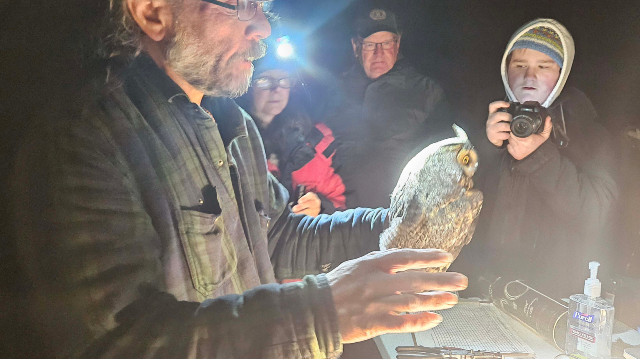By Carol Stiffler
Nova Mackentley and Chris Neri have handled thousands and thousands of owls – those magnificent raptors many people feel lucky to see once or twice a year.
Mackentley and Neri have been safely capturing and banding owls for decades with a passion that may approach obsession. They’re convinced it’s critical work.
Some migratory bird species are easy to spot – take robins, for example. They are loyal indicators of spring’s arrival, and it wouldn’t be hard to notice if we had more or fewer robins this year than last.
Owls, however, are nocturnal and hard to spot even if you can hear one is nearby. Some species of owl even migrate at night. Who would know if they were late to arrive, or if fewer managed to return this year?
Mackentley and Neri would. They become nocturnal each spring in a process Mackentley says gets harder as they get older, and spend their nights catching, studying, and releasing migrating owls. They are stationed at Whitefish Point north of Paradise, which is a migratory flyway. Mackentley is the director and Neri is the manager of Friends of Whitefish Point, the non-profit organization that also raises money to finance this work.
“Bands are really important for gathering types of data,” Mackentley said. “Without that, we would not know much about owls. We’ve had a spring season where we’ve captured 900 saw whet owls, the little guys. And during the day, two were found up at the Point that whole season. If it weren’t for the banding, we would not have any idea now many were moving through the area. We’d really just be completely in the dark.”
Mackentley and Neri, who are also a couple, play loud recordings of owl calls to lure the travelers in. The cacophony of sounds greet paying guests, who arrive at Whitefish Point around 10:30 p.m. and follow volunteers a short distance into the woods.
They set 11 mist nets – very fine, gentle mesh nets with generous “pockets” – and check them for owls every 45 minutes.
“Because the mesh is very soft, it doesn’t hurt them in any way,” Mackentley said. Mackentley and Neri have never had an owl get tangled in the net.
They retrieve the owls and bring them to a banding station in the nearby woods. Each owl is weighed, measured, inspected for body condition, and banded. A tiny aluminum band with a unique set of identifiers is gently closed around one ankle.
The bands are given out by the U.S. Geological Survey Bird Banding Laboratory, and don’t hurt or interfere with the bird. When a banded owl is recaptured, it’s a bit of a jackpot. “You get a ton of information,” Mackentley said. “Where it went, how long it took to get there, what the bird weighed, how it’s doing… Bands are really important for gathering types of data.”
Mackentley and Neri, with help from other trained staff, band owls from dusk to dawn during the spring migration, stopping at the end of May. They take a break in June, then work on summer banding. They band owls again in the fall. This year, their spring banding totals were:
Northern Saw-whet Owl: 612
Boreal Owl: 9
Long-eared Owl: 243
Barred Owl: 8
Great Horned Owl: 1
Though she’s handled more owls than she could possibly remember, Mackentley is still in awe of them.
“They’re very other worldly, I would say,” she said. “When you look at one, it’s like Christmas. Seeing something unexpected, always. I think that’s a gift. It’s like Christmas morning.”
Mackentley is grateful for supporters of the effort. A loyal team of volunteers eagerly assists with fundraising and promoting the organization. That includes retirees Jan and Curt Vogel, who guided guests to and from the banding station all spring long.
“Part of the reason we were drawn to this area is the birds,” said Jan Vogel. “It’s a major migratory flyway. People come from all over the world to Whitefish Point, which is not well publicized, but they do.”
She and her husband love owls – “What’s not to love about them?” she said – and live at Whitefish Point year round. “The fact that they make no noise when they fly. And those eyes… everything about them… We are just crazy about them.”
The Vogels are part of an active volunteer community that has rallied behind Friends of Whitefish Point and say they’re just happy to help sustain the work.
“There are so many individuals in this community who are behind them, and who are contributing,” Jan Vogel said.
Anyone can support the banding efforts by making a donation or purchasing tickets to a nighttime banding session. Tickets are $25 per person, and youth age 15 and under are free. To learn more, visit FriendsofWP.org.













